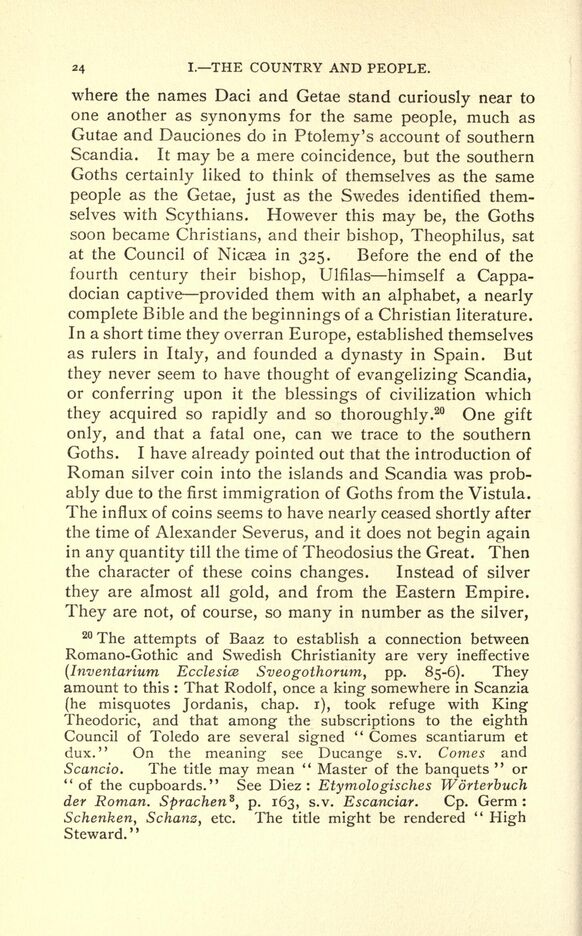
Full resolution (JPEG) - On this page / på denna sida - I. Introductory Lecture.—The Country and its Inhabitants in the Heathen Period up to 1000 A.D. - § 6. Second Period of the Iron Age

<< prev. page << föreg. sida << >> nästa sida >> next page >>
Below is the raw OCR text
from the above scanned image.
Do you see an error? Proofread the page now!
Här nedan syns maskintolkade texten från faksimilbilden ovan.
Ser du något fel? Korrekturläs sidan nu!
This page has never been proofread. / Denna sida har aldrig korrekturlästs.
24 I. THE COUNTRY AND PEOPLE.
where the names Daci and Getae stand curiously near to
one another as synonyms for the same people, much as
Gutae and Dauciones do in Ptolemy s account of southern
Scandia. It may be a mere coincidence, but the southern
Goths certainly liked to think of themselves as the same
people as the Getae, just as the Swedes identified them
selves with Scythians. However this may be, the Goths
soon became Christians, and their bishop, Theophilus, sat
at the Council of Nicaea in 325. Before the end of the
fourth century their bishop, Ulfilas himself a Cappa-
docian captive provided them with an alphabet, a nearly
complete Bible and the beginnings of a Christian literature.
In a short time they overran Europe, established themselves
as rulers in Italy, and founded a dynasty in Spain. But
they never seem to have thought of evangelizing Scandia,
or conferring upon it the blessings of civilization which
they acquired so rapidly and so thoroughly.
20
One gift
only, and that a fatal one, can we trace to the southern
Goths. I have already pointed out that the introduction of
Roman silver coin into the islands and Scandia was prob
ably due to the first immigration of Goths from the Vistula.
The influx of coins seems to have nearly ceased shortly after
the time of Alexander Severus, and it does not begin again
in any quantity till the time of Theodosius the Great. Then
the character of these coins changes. Instead of silver
they are almost all gold, and from the Eastern Empire.
They are not, of course, so many in number as the silver,
20
The attempts of Baaz to establish a connection between
Romano-Gothic and Swedish Christianity are very ineffective
(Inventarium Ecclesice Sveogothorum, pp. 85-6). They
amount to this : That Rodolf,
once a king somewhere in Scanzia
(he misquotes Jordanis, chap, i), took refuge with King
Theodoric, and that among the subscriptions to the eighth
Council of Toledo are several signed
"
Comes scantiarum et
dux." On the meaning see Ducange s.v. Conies and
Scancio. The title may mean "
Master of the banquets
"
or
"
of the cupboards." See Diez :
Etymologisches Worterbuch
der Roman. Sprachen
z
y p. 163, s.v. Escanciar. Cp. Germ:
Schenken, Schanz, etc. The title might be rendered
"
High
Steward."
<< prev. page << föreg. sida << >> nästa sida >> next page >>